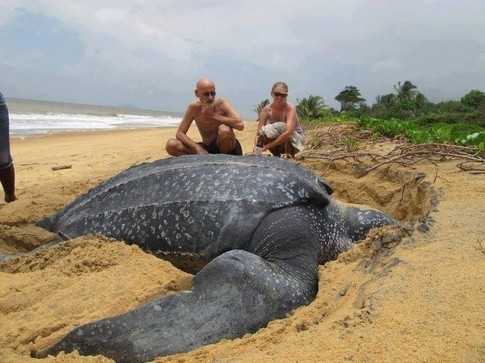Search for information
The Leatherback Turtle: Earth’s Colossal Marine Reptile Without a Traditional ShellThe leatherback turtle (Dermochelys coriacea) holds the title of the world’s largest turtle, capable of weighing up to 900 kilograms. Unlike other turtles, it lacks a hard bony shell. Instead, its back is supported by a flexible framework of bones covered by thick, rubbery skin, giving it a unique, leathery appearance that distinguishes it from all other chelonians.
June 23, 2025, 1:47 pm EDT

An Evolutionary Marvel: Adaptations for Oceanic Life
- Shell Structure Redefined
The leatherback’s "shell" is a mosaic of bony plates beneath dark, pebbled skin, topped by seven longitudinal ridges. This design reduces drag in water, allowing it to dive to depths of over 1,000 meters—deeper than any other turtle. Its body is streamlined for transoceanic journeys, with flippers spanning up to 2.7 meters, enabling it to migrate thousands of kilometers each year. - Thermoregulation Superpowers
As a semi-endothermic animal, the leatherback maintains body heat in cold oceans through adaptations like a thick layer of fat and efficient blood vessel arrangements. This allows it to thrive in waters where other turtles would freeze, making it a true master of extreme environments.
Global Wanderer and Conservation Concerns
- Diet and Life Cycle
Primarily feeding on jellyfish, the leatherback plays a crucial role in controlling jellyfish populations. Females return to tropical beaches to nest, digging pits and laying up to 100 eggs per clutch. Hatchlings face numerous threats, from predatory crabs to artificial lighting that disorients them from the sea. - Threats to Survival
Listed as "Vulnerable" by the IUCN, the leatherback confronts multiple perils: plastic pollution (mistaken for jellyfish), habitat loss from coastal development, and climate change (which skews egg sex ratios). Fishing gear entanglement also poses a significant risk, with thousands dying annually in commercial nets.

Cozy Dutch Winter Delights: Three Heartwarming Dishes to Warm Your Soul
As the chill of winter settles over the Netherlands, few things offer comfort like the country’s cherished traditional dishes. Slow-cooked, aromatic, and rich with flavor, these meals are more than just food—they’re a warm embrace on a frosty day. Here’s a closer look at three iconic Dutch winter specialties that have been warming hearts and bellies for generations.more

The All - Rounder: Mercedes - Benz EQS SUV
The Mercedes - Benz EQS SUV ingeniously integrates all the merits of the EQS sedan into a more appealing and multifunctional body. It's no surprise that it scores highly in our tests. Sharing the same platform and electrical architecture as the EQS sedan, the EQS SUV boasts a luxurious interior with high - quality materials and a dazzling 56 - inch Hyperscreen that stretches across the dashboard. The front seats are comfortable, and the second - row space is also very spacious. In addition, the flat floor design further increases the sense of space.more

The Enchanting Prostrate Dendrobium: A Botanical Jewel of Orchidaceae
The Prostrate Dendrobium (Dendrobium tortile), a captivating orchid species native to Southeast Asia and southern China, has long fascinated botanists and horticulturists with its unique growth habit and resplendent blooms. This epiphytic orchid thrives in tropical and subtropical forests, clinging to tree trunks or rocky cliffs in search of filtered sunlight and humid air.more

The Allure of Authenticity: Amateur Model's Story Unfolds in Foreign Beauty Photos Issue 118
The 118th edition of Foreign Beauty Photos introduces us to a compelling series of images featuring an amateur model, whose unpolished charm and genuine presence redefine the concept of beauty. This collection goes beyond mere aesthetics, offering an intimate look into the model’s world and the simple pleasures that shape her daily life.more

Exquisite Phalaenopsis: The Orchid that Captivates the World
Phalaenopsis, commonly known as the Moth Orchid, is one of the most beloved orchid genera worldwide, celebrated for its elegant blooms and remarkable adaptability. Native to tropical and subtropical regions of Asia, from India to the Philippines and Australia, these epiphytic plants have become a symbol of beauty in horticulture, gracing homes, gardens, and floral arrangements with their timeless charm.more

Golden Shrimp Plant: A Tropical Beauty Lighting up Gardens Worldwide
The Golden Shrimp Plant, scientifically known as Pachystachys lutea, is captivating gardeners and plant enthusiasts with its stunning appearance and unique charm. Native to the tropical regions of Central and South America, from El Salvador to Peru, this evergreen shrub has found its way into gardens and homes across the globe.more

Exotic Tropical Fruits of the Amazon: A Closer Look at Açaí, Cupuacu, and Graviola
Nestled in the heart of the Amazon rainforest lies a trove of unique tropical fruits, each with distinct nutritional profiles, traditional uses, and fascinating characteristics. Below is an exploration of three remarkable Amazonian fruits that have captured attention both locally and globally.more

The United States: A Global Leader in Economy and Technology
As the world’s universally recognized most developed nation, the United States has long dominated the global economy, consistently ranking first in economic power. Its technological prowess equally leads the world, with the nation achieving numerous global firsts in fields such as healthcare, electronic information, aerospace, and nuclear industry within its short 200 - year history. At the heart of this technological dominance is Silicon Valley, located in the southern San Francisco Bay Area of Northern California.more

